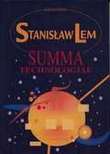Books
 Among Lem's essays Summa Technologiae occupies a central position, leaving behind cybernetic Dialogs, Fantastyka i Futurologia, Filolozofia Przypadku (an attempt at a "general theory of everything"). These other works are no less interesting, however Summa as a logical argument is "closed". It deals with problems that are even more important now than when the book was written - these issues are the most fascinating fulfillment of Lem's prognoses in the field of culture and technology.
Among Lem's essays Summa Technologiae occupies a central position, leaving behind cybernetic Dialogs, Fantastyka i Futurologia, Filolozofia Przypadku (an attempt at a "general theory of everything"). These other works are no less interesting, however Summa as a logical argument is "closed". It deals with problems that are even more important now than when the book was written - these issues are the most fascinating fulfillment of Lem's prognoses in the field of culture and technology.
Dialogs are partly "submerged" in an abstract of a philosophical dispute and current political topics; Fantastyka i Futurologia deals with problems of science fiction as a genre and its - usually dishonest - relationship with science. Filozofia Przypadku "erects a building of outlook" searching for structures common to biological evolution, history, culture, art, etc. In this respect Summa Technologiae is different: it is a summa and a "building", but in the sense of futuristic architecture. It presents daring hypotheses, shows the way, which -according to the author - human technological thought and culture will follow in the future.
It is amazing how much Lem got right, or even predicted. This ranges across artificial intelligence, the theory of search engines (he called it “ariadnology”), bionics, virtual reality (“phantomatics”), technological singularity and nanotechnology.
Simon Ings "New Scientist"
 Over twenty of Stanislaw Lem's works reached a print-run exceeding 30 million copies. These can be assigned to the following categories:
Over twenty of Stanislaw Lem's works reached a print-run exceeding 30 million copies. These can be assigned to the following categories:
1. Eden (1959), Return From the Stars (1961), Solaris (1961), The Invincible (1964), His Master's Voice (1968), Tales of Pirx the Pilot (1968) are works serious in tone, following the classic science-ficion route, broadened and perfected by Lem.
2. Grotesque works, hillarious on the surface, frequently styled as traditional literary forms (tales, a memoir, a philosophical tale): The Star Diaries (1957), Memoirs Found in a Bathtub (1961), The Cyberiad (1965), Inspection at the Scene of a Crime (1982), Peace on Earth (1987).
3. The Investigation, published in 1959, lies somewhere between a science-ficiton novel an a detective story, it is a peculiar negative of a detective romance. The Chain of Chance was published in 1976, which Lem considered a better, more convincing version of The Investigation.
4. Lem describes his childhood in Lvov in the autobiographical novel Highcastle (1966).
Page 2 of 2



